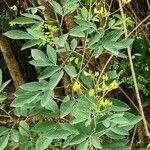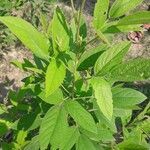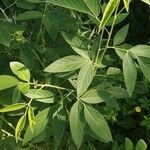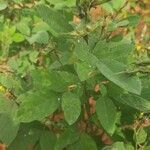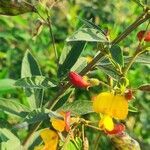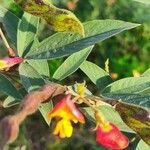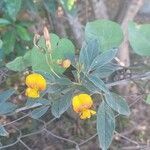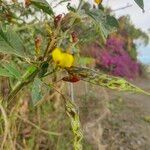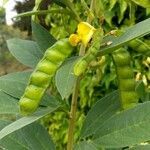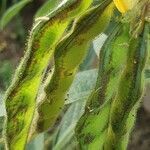Shrubs, erect, 1-3 m tall. Branchlets gray pubescent. Leaves pinnately 3-foliolate; stipules small, ovate-lanceolate, 0.2-3 mm; petiole 1.5-5 cm, sparsely pubescent; stipels extremely small; petiolules 1-5 mm, hairy; leaflets lanceolate to elliptic, 2.8-10 × 0.5-3.5 cm, papery, abaxial surface densely pubescent and with inconspicuous yellow glands, adaxial surface pubescent, apex acute or acuminate, usually mucronate. Raceme 3-7 cm; peduncle 2-4 cm; few flowers terminal or almost terminal; bracts ovate-elliptic. Calyx campanulate, 5-7 mm; lobes triangular or lanceolate, pubescent. Corolla yellow, ca. 3 × calyx in length; standard suborbicular, with inflexed auricle; wings slightly obovate, with short auricle; keel apex obtuse, slightly inflexed. Ovary hairy; ovules several; style long, linear, glabrous; stigma capitate. Legume linear-oblong, ± inflated, 4-8.5 × 0.6-1.2 cm, dun pubescent, apex beaked, acuminate, long mucronate. Seeds 3-6, gray, sometimes with brown spots, subspherical, ca. 5 mm in diam., slightly compressed; strophiole absent. Fl. and fr. Jan-Nov. 2n = 22.
An upright perennial shrubby legume. It lives for 3-4 years. They can be up to about 4 m tall and spreads to 1.5 m wide. The stem is erect and branching. It has a bushy appearance. It has a strong deep taproot. The root nodules are round and sometimes lobed. Young stems are angled and hairy. A leaf consists of 3 leaflets. Leaflets are narrow and green with a silvery green underneath. Leaflet size can be 10 cm x 3 cm. The end leaflet is larger with a longer leaf stalk. Flowers are red and yellow. The large petal has red lines. They are pea shaped and on branched flower stalks which stick upwards in the axils of leaves. Pods are long, straight and narrow, often with 4-8 seeds. The pods are slightly hairy. Pods are often 4-8 cm long and have a beak at the end. Pods are constricted between the seeds. Many varieties of pigeon pea occur. Some are dwarf and day length neutral. Seeds vary in shape, size and colour.
